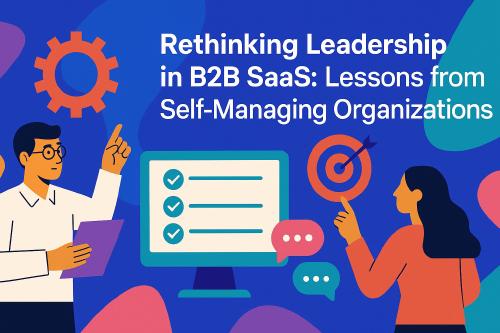Don’t motivate people
Now and then, when working with leaders, I get the question of how they could motivate their people. From their perspective, their people seem not motivated, not driven enough to bring the results they want to see.
My answer, of course, depends on the context, but always starts with a warning: You cannot and should not motivate people.
When people think about motivating people, they usually think about external rewards: Bonuses, promotions, words of affirmation, more interesting projects, …
All of this might work short-term but will harm the relationships of your employees with their work long-term.
If you dangle a carrot in front of peoples faces, you don’t motivate them to walk your way, but to reach the carrot. The problem is: once the carrot is reached, you need to dangle a tastier one in front of their face for continued progress.
And this is true even (or maybe, especially) for people who could have a high intrinsic motivation to achieve the goals, otherwise.
Extrinsic vs. Intrinsic Motivation
Intrinsic motivation refers to engaging in an activity for its own sake, driven by internal rewards such as personal satisfaction, curiosity, or a sense of accomplishment. When individuals are intrinsically motivated, they find joy in the work itself, leading to deeper engagement and creativity. For example, an employee who loves problem-solving may feel motivated to tackle a challenging project simply because it excites them and allows them to develop their skills.
Extrinsic motivation, on the other hand, involves performing an activity to earn external rewards or avoid negative consequences. This can include bonuses, promotions, recognition, or even the fear of punishment. While extrinsic motivators can be effective in the short term, they often fail to sustain long-term engagement. A classic example is an employee who works extra hours to earn a bonus; once the bonus is received, their motivation may vanish, leading to a drop in productivity.
Extrinsic motivation does not work
Bonuses, promotions and other benefits are extrinsic motivation. The issue is: Extrinsic motivation does not work. At least not long-term.
First, those extrinsic motivators are typically difficult to connect with company goals and thus motivate people to do something different from what would be good for the company. See my article “Bonuses are bad – change my mind”.
Second, humans are weird. Subconsciously, when we get rewarded for achieving a goal, we conclude that the goal itself isn’t worthy to be achieved. Otherwise, no extra motivation would be needed.
Thus, when leaders use extrinsic motivators to encourage people to achieve a goal, they harm the relationships of their people to this goal. In consequence, even more extrinsic motivation is needed. A vicious cycle.
To learn more about this dynamic, I recommend the outstanding book “Punished by Rewards: The Trouble with Gold Stars, Incentive Plans, A’s, Praise and Other Bribes” by Alfie Kohn.
Successful leadership connects intrinsic motivation to the job to be done
People cannot be motivated. Their motivation can be awakened. Once you manage to connect their intrinsic motivation with your goals, everybody wins. This is what leadership means: Inspire people to pursue a goal and help them understand why it is a worthy one.
This requires a strong relationship with the people around you. Talk openly about their motivators. What is important to them? What do they enjoy doing? How do they spend their free-time?
Understand what drives people and where they are intrinsically motivated. Find a connection between that and the work. Work should be the strategy to satisfy the underlying needs and interests.
Here are some questions that you can use to get to know people better and get an idea of their intrinsic motivation:
- What do you enjoy? What are your hobbies? What excites you?
- Why does it excite you? Why do you enjoy it?
- What aspect of it excites you in particular?
- Why is this important to you?
- Which part of your work (if any), gets closest to that?
- How can we make work more like that?
Asking the questions increases the opportunity to connect work and intrinsic motivation. The connection can happen in the what, the how and the why. The more connection points we can find between a person’s intrinsic motivation and the work, the better.
Occasionally, the connection can happen by telling a different story. If somebody is motivated to create a better world and the company is working on something in that direction, make that connection obvious. How will the world be better when your company achieves its vision?
Sometimes, the connection can happen by changing responsibilities. If someone enjoys riddles and tasks they really need to wrap their head around, they might shine more in debugging than in writing documentation. Somebody else might enjoy explaining complex matters in simple terms, or just have a passion for documenting things. That person might enjoy documentation more than being caught in a chaotic incident meeting trying to figure out what is wrong.
Purpose drives intrinsic motivation
In many companies, people’s work is completely disconnected from the companies’ purpose/mission/vision. Often the reason is that those are unclear, and you cannot be connected to a vision that isn’t clear.
This is why we usually include large parts of the employees in vision & strategy workshops. The process of co-creating those helps to understand and memorize them and also to identify with them. After all, the vision now isn’t a random statement by somebody else but something WE came up with.
With a clear purpose, it is much easier to connect everybody’s work with it. Given that the purpose is something the majority of employees supports and that is related to their ideals, purpose, or goals, the intrinsic motivation comes from alone.
Combine that with giving autonomy to pursue the goals and do everything necessary to make the vision come reality, and you will find that people are basically unstoppable. (Note: “necessary” includes “reshaping the organization” as rigid hierarchies are likely to kill intrinsic motivation again as they usually stand in the way of achieving goals efficiently)
To further support intrinsic motivation, give people space to build relationships with each other, have a sense of community and collaborate as they see fit. A strong feeling of belonging is a strong motivator for most people because of how our ancestors survived in the past by being part of clans and larger groups. Belonging brings safety, and safety is crucial for high performance.
Don’t confuse intrinsic and extrinsic motivation
Sometimes the lines between intrinsic and extrinsic motivation can become blurry, and it is common to see people use external motivators without being aware of it.
With the definitions from the beginning in mind, it should be easy to see, why bonuses, gamification, promotions, the fear of loosing a job or position and any form of recognition are extrinsic motivation.
That said, we can still recognize outstanding work, but it should be something surprising that comes after the job is done. Not as something that is promised upfront or known to exist. Acknowledgement and celebration of achievements after the work is done can have a positive effect. An “Employee of the month program”, on the other hand, can create a very unhealthy team dynamic.
Conclusion
If you are looking to motivate your team, it is important to understand that relying on external rewards like bonuses and promotions typically does more harm than good. Instead of trying to motivate your people, focus on helping them discover what inspires them from within. By building genuine relationships, taking the time to understand what excites each person, and connecting their work to a clear and meaningful purpose, you can create an environment where everyone feels engaged and driven by their passions.
Motivation is manifold. Each person is unique, and what inspires one person might not resonate with another. By asking questions and encouraging open conversations, you can uncover the intrinsic motivators that matter to your team. This approach not only increases job satisfaction but also nurtures a sense of ownership and commitment to the goals you are working toward together.
When your team members find personal meaning in their work and feel a sense of belonging, they become more than just employees chasing rewards. They transform into passionate contributors who genuinely care about the success of the organization. By prioritizing intrinsic motivation over external incentives, you can create a positive workplace culture that encourages creativity, innovation, and sustained high performance.
Success does not come from dangling carrots, but from empowering each person to pursue their passions and connect their work to a larger purpose.
What are your thoughts on this topic? Share them in the comments. 👇





Use the share button below if you liked it.
It makes me smile, when I see it.